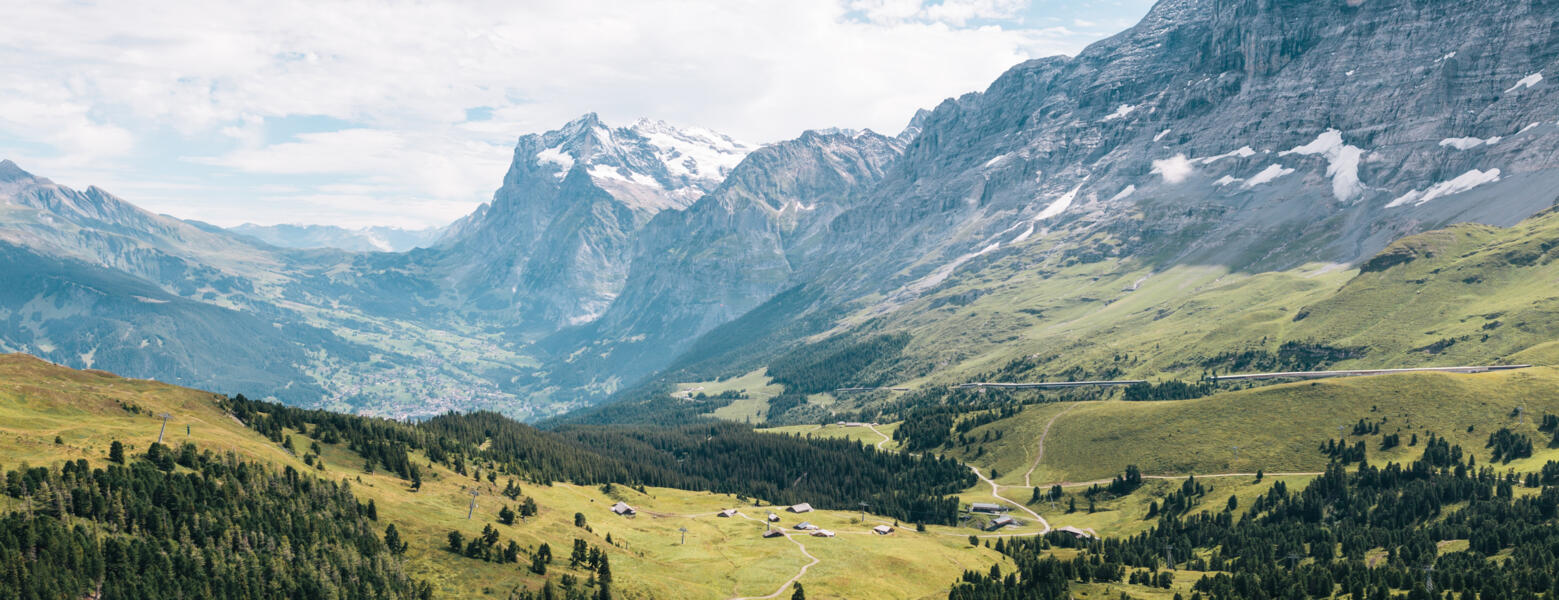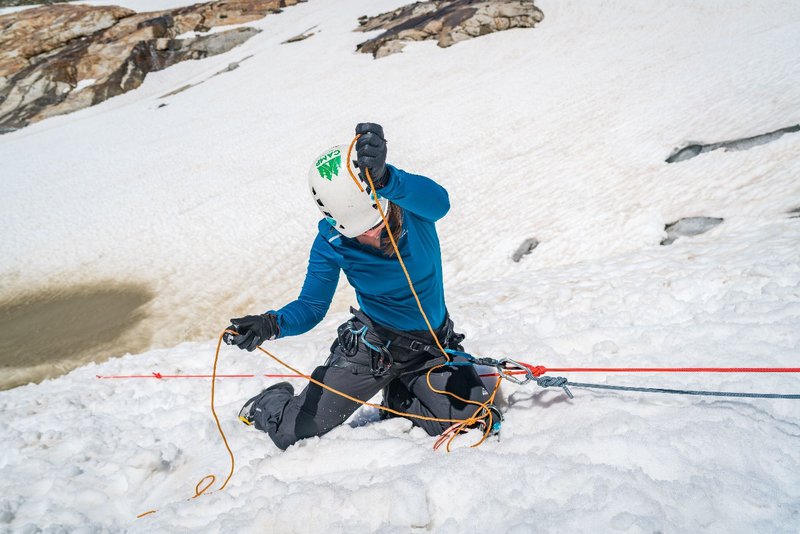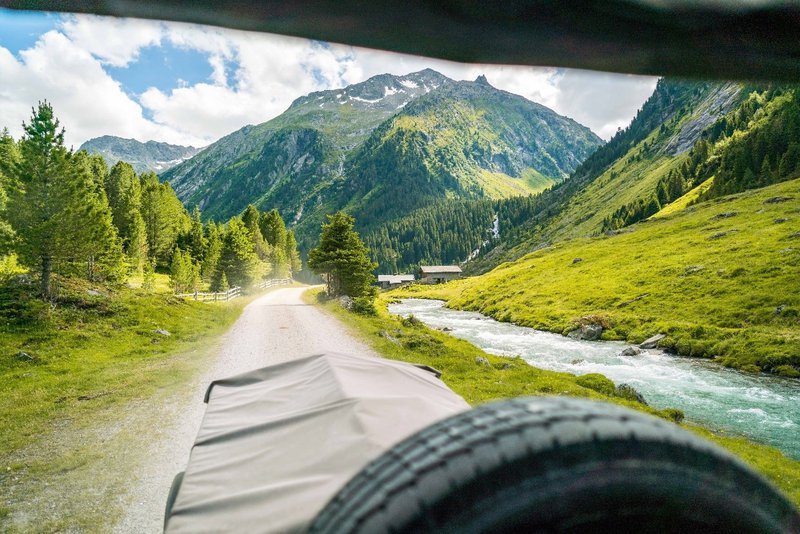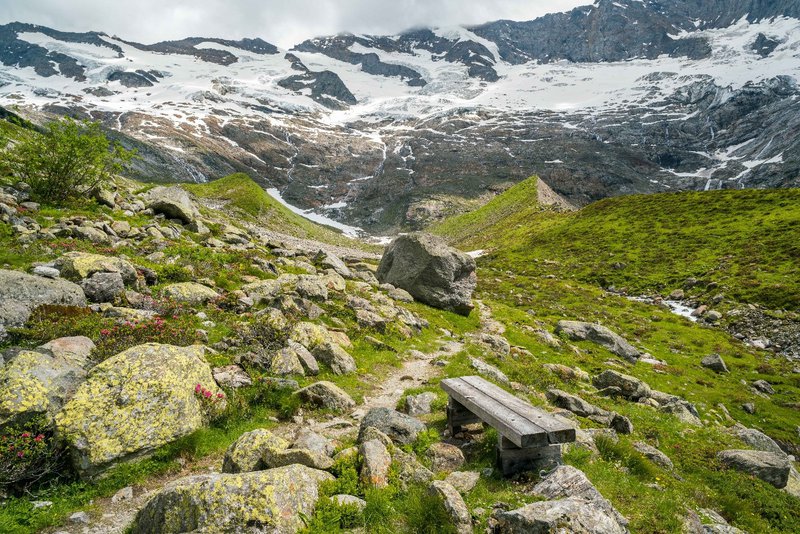
Freedom of nature
Sustainable getaways
Real human connections
My mountaineering course – a week away from the rest of the world
The seclusion, unspoiled nature, and harsh terrain make the high alps a very special place. In this blog, Ramona shares her first experiences in mountaineering and gives some tips about how you can get into mountaineering yourself.
I simply love getting to the top of a mountain after a long, strenuous hike and looking at the world stretching out beneath you. The complete exhaustion mixed with triumph, the pure joy combined with awe about the beauty of it all, the feeling of standing on top of the world, but feeling incredibly small at the same time – This is one of my favourite feelings in the world.
My name is Ramona and over the last couple of years, I turned into a total rock-climbing addict and mountain enthusiast. In this time, I went on a number of outdoor adventures. However, one of my absolute highlights was a beginner’s mountaineering course I took part in last summer. In this article, I would like to share my experience of this adventure with you.
What is Mountaineering?
This is a question you might find asking yourself. Mountaineering, or alpinism, is basically a set of outdoor activities needed to ascend tall mountains, such as those found in the alps. So, what is the difference to hiking? Hiking is of course an important part of mountaineering, but it includes a lot more activities revolving around rock, snow, and ice; It includes rock climbing, ice climbing, glacier traversing, ski mountaineering and other activities. So, it comprises all skills needed to safely move on the tricky terrains you find in the mountains.

My mountaineering course
The alpine course I signed up for was going to take place in the Venediger Group, a mountain range in the Central Eastern Alps and take seven days. To get acclimatized and to get to know my fellow course mates, I already went to Austria a couple of days before the official start of the course for some camping. On the evening before the first day, we all checked our gear, excitedly shared our expectations and first experiences, and went to sleep with a feeling of eager anticipation.
Our first day started off with a big surprise. Me and the other participants were waiting for our mountain guide at the agreed upon meeting point with our heavy backpacks, excited and ready to embark on a hike to the mountain hut we would be staying in for the week with 20 kilometers of distance and 1.200 meters in height to overcome. However, our guide had other plans: He had organised a minibus for us that brought us up most of the way, leaving us with a two-hour hike only. I cannot say that I minded too much - This way, we had more time to practice rope techniques that day. Also, I was sure that there was going to be more than enough hard hiking in the coming days.

The following seven days we spent learning how to safely move in all types of terrains, including rock, snow, and ice, as this is the foundation for every mountaineer. I learned how to belay my fellow course members when ascending tricky ridges, how to walk on steep ice and snow, how to rappel down from a peak, and much more.
However, my very favourite part of the course was learning how to safely cross glaciers. When walking on a glacier, there is always the danger of falling into a crevasse that is not visible due to a top-layer of snow covering it. Therefore, you bind into a rope with usually three to five people during the crossing, so that the other people of your rope group can catch you in case of a fall. Of course, we also practiced different techniques of crevasse rescue to be able to help ourselves in such a dangerous situation. How? Well, we tied into a rope, one of us jumped into a crevasse, and with different rescue techniques we pulled this person out again. Sounds scary? It is really not, it was actually a lot of fun. Of course, we had practiced the techniques on safe terrain first and we always had a mountain guide supervising us carefully.
Besides all the time outside in the mountains, we also had some theoretical course content. Amongst others, we learned about how to plan and prepare easy alpine tours by ourselves, alpine danger recognition, glaciers, required material, and weather systems. Though this might sound a bit boring, I actually found it really interesting. Also, this knowledge is essential if you want to safely embark on mountaineering tours by yourself.

The unexpected pleasures are the best
While being outside among snow and rock is great, coming back to the hut each afternoon was also among my favourite moments. Sitting outside of the hut, eating some hearty food, and enjoying a nearly obligatory “Weißbier” while watching some marmots play in the snow is the perfect kind of reward after a long, straining day.
Retrospectively, the thing I enjoyed the most was the near-total seclusion from the rest of this world in this week. There was no internet, no news, no cell phone reception – simply no contact with the outside world. In our hyperconnected, globalised world, amid the corona crisis, this was a very welcome change. Life in the mountains somehow seemed slower, more focused on the moment, easier.
The week passed in a flash. Though the days were very physically demanding and getting up very early each morning took a strain on, it felt like we had just arrived when we were already hiking down to the mountain road again and took the minibus down into the valley.

Five steps to mountaineering
Are you excited now to get into mountaineering yourself? Awesome! Here are some important things to consider beforehand:
1. Go hiking
Just start where you are at; Going on some fun hikes in your neighborhood is a wonderful beginning. Then slowly scale it up! It is definitely a good idea to go on some multi-day hikes beforehand to see how you like being on the move with a heavy backpack for days at a time. Moreover, a multi-day hut tour in the mountains is recommendable to find out whether mountaineering would be something for you. Not only is it important to be comfortable on mountain trails, but also sleeping in a mountain hut is not for everyone. The life up there is mostly very basic, there is little comfort or luxury, and you typically sleep in dorms with multiple people. Additionally, experiencing how you cope with being at high altitudes for longer periods of time is valuable.
2. Book a suitable course
You are convinced that you really want to do a mountaineering course? Great! Then you just have to choose a course that suits you. Make sure to book a course that is in accordance with your current skill level. For some beginner courses, there might be requirements such as familiarity with outdoor rock-climbing rope techniques. If you are not sure whether you possess the required level of skill, always feel free to reach out to the organisation, they will be happy to help you. There are many different organisations that offer courses, depending on where you are located. It is always good to check out the alpine club of your country, such as the DAV for Germany, NKBV for the Netherlands or the ÖAV for Austria. The most important thing that you should pay attention to is that the course is given by mountain guides that are certified by the International Federation of Mountain Guides Association.
2. Get fit
You do not need to be a world-class athlete if you want to do a beginner’s alpine course. However, you should be reasonably fit and have good endurance. After all, being on the move in the mountains all day with a heavy backpack is no piece of cake. Regular endurance training such as running, or cycling is great. Moreover, building upper body strength is important. An optimal way to do this is to go sport climbing at your local climbing gym. This way you also have the chance to already get acquainted with handling a rope, wearing a harness, and belaying. I personally started to go running five to ten kilometers at least two times a week to improve my endurance some months before the course started. Combined with going climbing regularly and occasional hikes on the weekends, this was a pretty good preparation.
3. Get the gear
When you go mountaineering, proper gear is essential for your safety. However, most of the expensive things can mostly be rented from organisations that offer courses. Do not buy crampons, ice axes, or ropes before you are sure of what you like and need. However, there are some important things to have; A good, light-weight backpack that fits your gear, a climbing harness, suitable mountain boots, and some small pieces of gear such as carabiners you will need to get yourself. Make sure to check details with your organisation. Moreover, multiple layers of functional clothing that prepare you for all weather conditions are essential.
4. Stay safe
Always be careful and mindful of your limits. Do not overestimate yourself and only do what you feel safe with. Never go on mountaineering trips without a licensed guide or having done a course beforehand. You might feel like a pro after having watched those hundreds of YouTube videos but believe me, it is not that easy. The alpine territory is dangerous, especially without the proper experience and knowledge.
5. Enjoy!
Lastly, but most importantly: Enjoy your time in the mountains. Whether you just do an easy hike through the hills in your neighbourhood, a hut-tour in the alps, or a full mountaineering course, always remember to have fun.
Did you like this article and you want to see more about my next Outdoor Adventures? Then follow me on instagram @ramona.doliff .
Find your sustainable getaway
Up to 95% CO2 reduction if you book a campspace adventure. Learn more